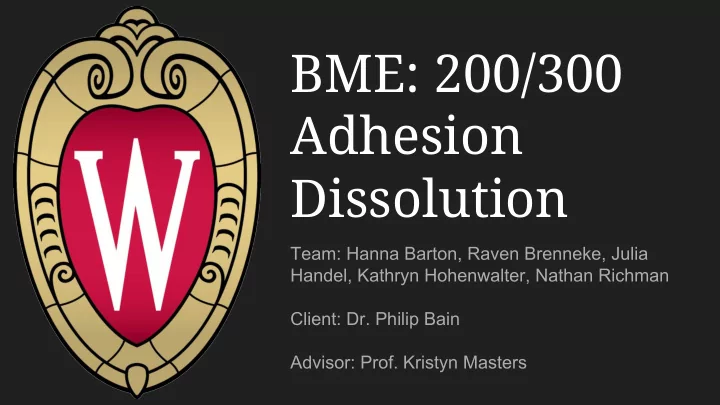

BME: 200/300 Adhesion Dissolution Team: Hanna Barton, Raven Brenneke, Julia Handel, Kathryn Hohenwalter, Nathan Richman Client: Dr. Philip Bain Advisor: Prof. Kristyn Masters
Overview ● Background Information ● Project Problem Statement ● Summary of Design Specifications ● Design Overview ○ Hydrogel ○ Chemical Scalpel ○ Genetic Targeting ● Design Evaluation ● Future Work ● Conclusion
Background on Adhesions ● What are adhesions? ○ bands of scar-like, connective tissue that connect organs that are usually unattached ● What causes adhesions? ○ Adhesions can be caused by upper and lower abdominal surgeries ○ They form in anywhere from 67-100% of patients who undergo abdominal laparotomies ● Why do we care? ○ 15-18% of those with adhesions face complications (i.e. small bowel obstructions) that require surgical removal Buåureanu et al 2014 https://www.niddk.nih.gov/health-information/health-topics/digestive-diseases/abdominal-adhesions/Pages/facts.aspx
Adhesion Formation & Maturation ● New adhesions are made of fibrin ● As they mature, they become a collagenous extracellular matrix R. T. Beyene et al 2016
Project Problem Statement Abdominal Small Bowel Surgery Obstructions Adhesion Small Bowel Removal Obstructions Surgery Adhesion Removal Surgery ● Our task: less invasive, more natural solution
Design Specifications ● Must sever and reduce adhesion volume by >50% ● Must degrade mature adhesion (not preventative) ● Contain 98% of administered enzyme to adhesion ● Device and enzyme must be viable for FDA approval
Possible Targets for Adhesion Dissolution 1. Vasculature 2. Cells 3. Extracellular Matrix (collagen) ● Vascular/cell removal - prevent growth ● ECM removal - degrade structure https://www.niddk.nih.gov/health-information/health-topics/digestive-diseases/abdominal-adhesions/Pages/facts.aspx, https://en.wikipedia.org/wiki/Adhesion_(medicine)
Solution: ECM degradation ● ECM regulation: ○ Matrix Metalloproteinases (MMPs) ■ degrade ECM ○ Tissue Inhibitor of Matrix Metalloproteinases (TIMPs) ■ inhibit MMPs ● Target ECM with MMP delivery R. T. Beyene et al 2016
Design 1: Hydrogel ● Hydrogel ○ Diffuse MMPs selectively to the adhesion ECM ○ Controls the MMP ○ Laparoscopic Techniques http://www.healthbenison.com/abdominal-adhesions-treatment/ http://newatlas.com/temperature-controlled-hydrogel-movement/38865/ https://en.wikipedia.org/wiki/Laparoscopy
Design 2: Chemical Scalpel ● Chemical Scalpel ○ Laparoscopic Method ○ Localized MMP release ○ Probe like design ○ User takes the probe and ‘spots’ the adhesion with MMPs ○ Need to use an MMP with short half life https://en.wikipedia.org/wiki/Adhesion_(medicine) http://www.directindustry.com/prod/solartron-metrology/product-4818-57437.html
Design 3: Gene Therapy-Endogenous MMP ● Gene Therapy ○ Endogenous MMP attack ○ Internally produce excess MMPs in the cells in adhesions ○ Uses the body's natural processes https://en.wikipedia.org/wiki/Matrix_metalloproteina se https://www.researchgate.net/figure/273955929_fig1_Figure-1-MMP-domain-stru cture-and-protein-fold-A-The-various-domain-organizations-of
Design Matrix Criteria Weight Design 1: Hydrogel Design 2: Chemical Scalpel Design 3: Gene Therapy Safety (30) 4/5 24 3/5 18 4/5 24 Performance (25) 4/5 20 3/5 15 5/5 25 Simplicity (20) 3/5 12 4/5 16 1/5 4 (Ease of Use, Risk of Failure) Cost (15) 4/5 12 3/5 9 1/5 3 Fabrication (10) 4/5 8 3/5 6 1/5 2 Total (100) 76 64 58
Future Work ● Choose appropriate MMP ○ Criteria: collagen-specific, appropriate half-life, effective degradation performance ● Hydrogel Selection and fabrication ● Testing ○ MMP ■ Determine concentration ○ Hydrogel ■ Effectiveness ■ Surgical feasibility http://labs.bio.unc.edu/harris/Courses/biol441/two_point_aligned_collagen.jpg
Acknowledgements ● Prof. Kristyn Masters ● Dr. Philip Bain ● Dr. Ross Molot
Questions?
References R.T. Beyene et al. (2016). Intra-abdominal adhesions : Anatomy , physiology , pathophysiology , and treatment, 52 (2015), 271–319. http://doi.org/10.1067/j.cpsurg.2015.05.001 Buåureanu, Æ. A., & Buåureanu, T. A. S. (2014). Pathophysiology of Adhesions, (3), 293–298.
Recommend
More recommend